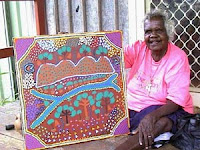I was lucky enough to have been able to have a look at these pieces of work up close and personal, as they are a part of my boyfriend’s family collection of Indigenous artwork.
Talking to my boyfriend’s Mum, who grew up at Yirrkala Station, she says that these bark paintings were painted in 1950’s and early 1960’s. They were painted by Aboriginal men who became friends with her father whilst they were living at Yirrkala, which is at the north-eastern tip of Arnhem land.
These paintings weren’t commissioned by they were given to Doug Tuffin who was working in the region as a missionary come agriculturalist farmer.




 The detail in these works are just exquisite and the colours are amazing. After learning about Arnhem land in the lectures I instantly recognised where these paitings were from just by the Rark that is used. I would love to know what the stories are behind these bark paintings, as they are just so detailed and beautiful.
The detail in these works are just exquisite and the colours are amazing. After learning about Arnhem land in the lectures I instantly recognised where these paitings were from just by the Rark that is used. I would love to know what the stories are behind these bark paintings, as they are just so detailed and beautiful. What intrigues me is that these pieces of work were only made with ochre and local pigments mixed with water. This means that the pieces are very fragile and at some stage will need to be looked at to set the colour properly. It makes me wonder why no binder was used when painting this.





































